![]()
![]()
![]()
Use LEFT and RIGHT arrow keys to navigate between flashcards;
Use UP and DOWN arrow keys to flip the card;
H to show hint;
A reads text to speech;
14 Cards in this Set
- Front
- Back
|
STOCK PRICE
Explain the effect on a company’s stock price today of each of the following events, other things held constant. a. The interest rate on bonds falls. |
Because bonds are a substitute asset for stocks, this will lead to a rise in all stock prices, including this company’s stock price.
|
|
|
b. Several companies in the same sector announce surprisingly higher sales.
|
This will lead to an immediate rise in the company’s stock price because it is unexpected information that communicates to investors that the company’s sector is doing well, and so it is likely that the company will also experience higher sales and a higher-than-expected future profit.
|
|
|
c. A change in the tax law passed last year reduces this year’s profit.
|
This will have no effect on the company’s stock price today because the effect of the change in the tax law on this year’s profit would have been incorporated into the company’s stock price when the tax law change was announced.
|
|
|
d. The company unexpectedly announces that due to an accounting error, it must amend last year’s accounting statement and reduce last year’s reported profit by $5 million. It also announces that this change has no implications for future profits.
|
This will have no effect on the company’s stock price today because the stock price is based on expectations about the future stock price, and this is unaffected by changes in previous years’ profits.
|
|
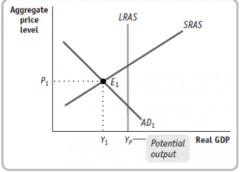
ALBERNIA CURRENT ECONOMIC SITUATION
a. Is Albernia facing a recessionary or inflationary gap? |
Albernia is facing a recessionary gap; Y1 is less than YP.
|
|
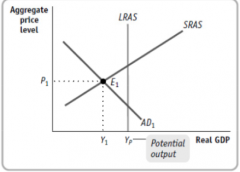
b. Which type of fiscal policy—expansionary or contractionary—would move the economy of Albernia to potential output, YP? What are some examples of such policies?
|
Albernia could use expansionary fiscal policies to move the economy to potential output. Such policies include increasing government purchases of goods and services, increasing government transfers, and reducing taxes.
|
|
|
c. Illustrate the macroeconomic situation in Albernia with a diagram after the successful fiscal policy has been implemented.
|
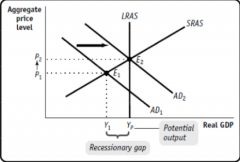
|
|

MONEY SUPPLY & INTEREST RATE
The money market is initially in equilibrium when the economy begins to slide into a recession. a. Using the accompanying diagram, explain what will happen to the interest rate if the central bank keeps the money supply _constant at M1. |
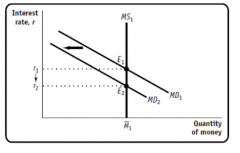
Beginning at equilibrium point E1 in the accompanying money market diagram, when the economy goes into recession, aggregate spending will fall and the money demand curve will shift to the left, from MD1 to MD2, moving the money market from its initial equilibrium, E1, to a new equilibrium at E2. If the central bank keeps the quantity of money constant, the interest rate will decrease to r2, shown at the new equilibrium point, E2.
|
|
|
b. If the central bank is instead committed to maintaining an interest rate target of r1, then as the economy slides into recession, how should the central bank react? Using your diagram from part a, demonstrate the central bank’s reaction.
|
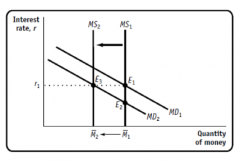
If the central bank is committed to maintaining an interest rate target of r1, then the central bank will reduce the money supply as the economy goes into recession, from MS1 to MS2 in the accompanying diagram, eliminating the potential for interest rates to fall. The new equilibrium in the money market is at E3, with the interest rate at its target rate, r1.
|
|
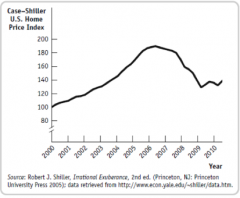
HOME PRICE INDEX
In the following figure showing the Case–Shiller U.S. Home Price Index from 2000 to 2010, did housing prices peak before or after the financial crisis in the United States? Explain your answer. |
In the United States, housing prices peaked in 2006, two years before the height of the financial crisis in October 2008. As in Sweden, Japan, and Finland, the fall in housing prices caused many borrowers to default on their mortgages. This led to massive losses in the financial sector and precipitated the financial crisis of 2008.
|
|
|
JAPAN U.S. TRADE
Suppose the United States and Japan are the only two trading countries in the world. What will happen to the value of the U.S. dollar if the following occur, other things equal? a. Japan relaxes some of its import restrictions. |
If Japan relaxes import restrictions, Japanese residents will demand more U.S. goods and more U.S. dollars to buy those goods. The U.S. dollar will appreciate due to the increase in the demand for U.S. dollars.
|
|
|
b. The United States imposes some import tariffs on Japanese goods.
|
If the United States imposes import restrictions, Americans will buy fewer Japanese goods. Americans will want to exchange fewer U.S. dollars for yen, so the supply of U.S. dollars will decrease and the U.S. dollar will appreciate.
|
|
|
c. Interest rates in the United States rise dramatically.
|
A dramatic rise in U.S. interest rates will attract Japanese buyers of American assets as well as discourage Americans from buying Japanese assets. There will be an increase in the demand for U.S. dollars and a decrease in the supply of U.S. dollars; the U.S. dollar will appreciate.
|
|
|
d. A report indicates that Japanese cars last much longer than previously thought, especially compared with American cars.
|
A report indicating that Japanese cars last much longer than previously thought, especially when compared with American cars, will increase the demand for Japanese cars and the demand for Japanese yen. The yen will appreciate and the U.S. dollar will depreciate.
|

